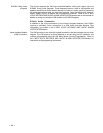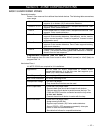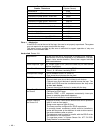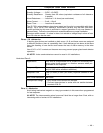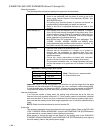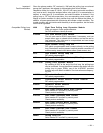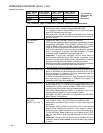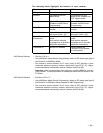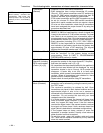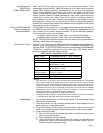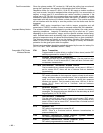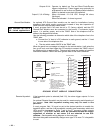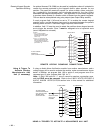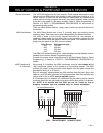
Ð 24 Ð
Transmitters
NOTE: After replacing a low or
dead battery, activate the
transmitter and enter the
security code + OFF to clear its
memory of the "Low Battery"
signal.
The following table summarizes wireless transmitter characteristics.
Transmitters ¥ Supports 5700 or 5800 series transmitters.
(General) ¥ Each transmitter has a unique transmitter ID number
(Zone #). 5700 series transmitters use DIP switches to
set the ID. 5800 series transmitters must have their ID
numbers "enrolled" by the system or downloaded.
¥ 5700 series transmitters and the 5827 keypad must also
be set for a house ID. Other 5800 series transmitters
have built-in serial numbers and do not require a house
ID to be set. After installation, check that all transmitters
have been assigned the proper house ID by using the
procedure described later.
Trans. Supervision ¥ Each transmitter (except 5701, 5727, 5801, 5802,
5802CP, & 5804) is supervised by a check-in signal that
is sent to the receiver at 70-90 minute intervals. If at least
one Check-in is not received from a transmitter within a
programmed interval (field 1*31), the keypad will display
the transmitter number and "CHECK" will be displayed.
¥ Each transmitter (including 5701; 5727, 5801, 5802, &
5802CP) is also supervised for low battery conditions,
and transmits a low battery signal when the battery has
approximately 30 days of life remaining. The keypad
displays the transmitter number and "LO BAT".
5800 Series "Enroll" ¥ 5800 series transmitters have built-in serial numbers that
must be "enrolled" by the system during on-site
programming. Refer to PART 2. PROGRAMMING
PROCEDURES section for details.
Checking Trans. ¥ To check that all transmitters have been set properly,
Operation including program the receiver to the proper house ID, if required,
DIP & serial number and enter the Installer code + [#] + [3].
(Code + [#] + [3]) ¥ All transmitters that have been enabled for the partition in
which the test was initiated will be displayed. As each
transmitter checks in (up to 2 hours), its ID number will
disappear. A faster way to do this is to fault each
transmitter, which causes a transmission to be sent to the
receiver. When all transmitters have checked in, there
should be no ID numbers displayed.
¥ Repeat check for each partition using RF transmitters.
"Go/No Go" Test ¥ This mode helps determine the best location for each
Mode (Patented) transmitter and is activated by putting the control panel in
the TEST mode.
¥ The receiver's sensitivity is reduced by half. Once
transmitters are placed in their desired locations and the
approximate length of wire to be run to sensors is
connected to the transmitter's screw terminals, fault each
transmitter.
Do not conduct this test with your hand
wrapped around the transmitter.
¥ If a single receiver is used, the keypad will beep three
times to indicate signal reception. If two receivers are
used, the keypad will beep once if the first receiver
received the signal, twice if the second receiver received
the signal and three times if both receivers heard the
signal (which is desirable for redundant configurations).
¥ If the keypad does not beep, reorient or move the
transmitter to another location. Usually a few inches in
either direction is all that is required.
¥ To exit this mode, enter the installer code and press
OFF. Note that the Receiver's sensitivity is fully restored
when this mode is exited.



